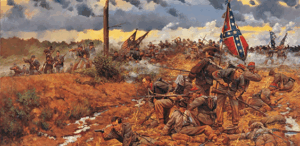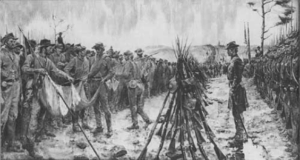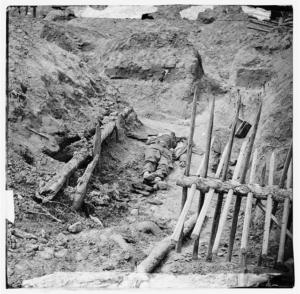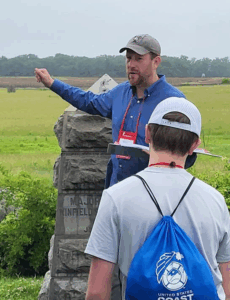A BGES Civil War Field University Program
with Phillip S. Greenwalt
May 6–10, 2026; from Chester, VA


The Siege of Petersburg, considered the longest in American military history, lasted for 292 days, from June 1864 to early April 1865. The combined Federal armies under Gen. Ulysses S. Grant gradually wore down the Army of Northern Virginia under Gen. Robert E. Lee.
Throughout the summer of 1864, Grant attempted various maneuvers to break the stalemate. One of these efforts involved detonating explosives beneath a section of the Confederate defenses. The resulting engagement, known as the Battle of the Crater, ended in a costly Federal defeat. Other operations throughout the summer sought to stretch Lee’s defenses and cut off vital supply lines into Richmond and Petersburg.
Lee’s final offensive at Fort Stedman on March 25, 1865, failed after initial success. Six days later, on April 1, Maj. Gen. Philip Sheridan delivered a blow to the Confederate defenses by capturing a critical crossroads at Five Forks. Grant launched an offensive the following morning, finally breaking the Confederate line. That night, Lee began evacuating his Petersburg defenses, hoping to move west and south to unite with other Confederate forces in the Carolinas. But seven days later, surrounded and exhausted, he was forced to surrender at Appomattox Court House, roughly 90 miles to the west.
This immersive tour follows the campaign from the early siege operations at Petersburg through the battles of the Crater, Fort Stedman, and Five Forks, before turning westward to trace the Appomattox Campaign, ending the war in Virginia.
Join BGES for this exceptional program with historian and National Park Service Ranger Phillip S. Greenwalt, who will lead four days of on-the-ground exploration and detailed analysis of Lee’s final campaign.

Itinerary
Wednesday May 6, 2026 – Orientation (6–7 p.m.)
Meet Phill Greenwalt and your fellow participants at the headquarters hotel at 6 p.m. to receive nametags and program packets. A 45-minute introductory lecture will set the stage for the Overland Campaign and the lead-up to the Siege of Petersburg, providing valuable context for what we’ll explore on the ground.
Dinner is on your own.
Day 1: Thursday, May 7, 2026 (8 a.m.–4:30 p.m.)
Our first full day takes us straight into the heart of the campaign. Departing from the hotel in the morning, we’ll begin at Drewry’s Bluff, where Confederate defenders once guarded the James River approaches to Richmond. A short, scenic walk up to the preserved earthworks reveals sweeping views of the river and provides insight into how the Confederates protected their capital from naval assault.
From there, we continue to City Point, the strategic nerve center of Grant’s operations during the siege. Once a quiet plantation community, City Point became one of the busiest ports in the world by 1864—a logistical marvel that sustained the Federal armies through months of grueling trench warfare. Here, we’ll discuss Grant’s command strategy and the role this hub played in managing both the siege and the larger Federal war effort.
We then trace the Confederate Howlett Line, the defensive system linking Richmond and Petersburg, before breaking for lunch. The afternoon brings us to the Eastern Front of Petersburg National Battlefield, where we’ll explore the visitor center and walk to “The Dictator,” the massive mortar that thundered across the lines during the siege.
Our final stop is the haunting landscape of The Crater, site of one of the most dramatic and tragic episodes of the entire campaign. Standing among the rolling earthworks, we’ll examine how a daring Federal plan to tunnel beneath the Confederate lines turned into disaster—and how the lessons learned there shaped the remainder of the war.
Lunch is included, but dinner is on your own.
Day 2: Friday, May 8, 2026 (8 a.m.–5 p.m.)
We begin today with a closer look at Grant’s summer 1864 offensives, when he and General George Meade sought to sever Lee’s vital supply lines. Stops along the Jerusalem Plank Road and Weldon Railroad illustrate the relentless series of thrusts and counterthrusts that defined the long siege.
Next, we turn to Fort Stedman, the site of Lee’s final offensive on March 25, 1865. Here, Phill will walk us through the desperate dawn assault that briefly pierced the Union line before collapsing under a fierce counterattack—Lee’s last gamble before the end.
After lunch, we’ll follow the campaign’s momentum westward to Dinwiddie Court House, where the final chess moves of the Petersburg struggle began. From there we move to Five Forks, where Sheridan’s April 1 victory decisively broke the Confederate defenses and forced Lee’s retreat. Walking the battlefield, we’ll examine how poor coordination among Confederate units and swift Federal maneuvering sealed the fate of Petersburg.
Our day concludes with a visit to South Side Depot, now the Petersburg City Visitor Center. It was here that Confederate forces began their evacuation—an ending that would quickly give way to Lee’s final march. We’ll return to Chester in the late afternoon.
Lunch is included, but dinner is on your own.
Day 3: Saturday, May 9, 2026 (8 a.m.–5 p.m.)
Today we follow in Lee’s footsteps as the retreat unfolds. Our first stop is Amelia Court House, where miscommunication and missing supplies slowed Lee’s army and cost him precious time. From there, we continue west to Sailor’s Creek, scene of catastrophic defeat on April 6, 1865. As we tour the battlefield, Phill will describe how nearly a quarter of Lee’s army was lost—captured or killed—in one of the war’s final large-scale engagements.
Moving on to High Bridge, we’ll walk a section of the span where retreating Confederates attempted to burn the structure to halt the Union pursuit. The bridge’s survival ensured that Federal forces could continue pressing westward. After lunch in nearby Farmville, we’ll drive to Appomattox, where the final actions of the campaign played out on April 8–9, 1865. Here, we’ll discuss the tactical and logistical realities that left Lee with no choice but to surrender.
By late afternoon, we’ll return to Chester, having retraced the desperate final week of the Army of Northern Virginia.
Lunch is included, but dinner is on your own.
Day 4: Sunday, May 10, 2026 (8 a.m.–5 p.m.)
Our final day is devoted to reflection and remembrance at Appomattox Court House National Historical Park. We’ll spend the morning exploring this remarkably preserved village, visiting the small cemetery, courthouse visitor center, and the McLean House, where Grant and Lee met to agree upon terms of surrender. Standing at the stacking of arms site, you’ll sense the solemn dignity of that moment—both an ending and a beginning in the nation’s story.
Before returning to Chester, we’ll stop briefly at Lee’s last bivouac, where he spent the night before surrendering. We expect to arrive back at the hotel by late afternoon.
Lunch is included.
About the Faculty

Phill Greenwalt is a full-time contributor to Emerging Civil War and cofounder of Emerging Revolutionary War (www.emergingrevolutionarywar.org). He currently serves as the program manager for Interpretation and Education at Catoctin Mountain Park.
Before joining Catoctin, Phill spent six years as a supervisory park ranger at Everglades National Park after seven years as a historian with the National Park Service at George Washington Birthplace National Monument and Thomas Stone National Historic Site. He began his National Park Service career as a historical interpreter intern at Fredericksburg and Spotsylvania National Military Park, where Greg Mertz hired and trained him.
Phill has participated in major National Park Service commemorations, including the Sesquicentennial of the surrender at Appomattox Court House and the Bicentennial of the Battle of Fort McHenry and the writing of the Star-Spangled Banner.
He is the co-author of Bloody Autumn: The Shenandoah Valley Campaign of 1864, Hurricane from the Heavens: The Battle of Cold Harbor, and Calamity in Carolina: The Battles of Averasboro and Bentonville (all three with Daniel Davis). He has also contributed two volumes to the Emerging Revolutionary War Series: The Winter That Won the War, The Winter Encampment at Valley Forge 1777-1778; and, with Rob Orrison, A Single Blow, The Battles of Lexington and Concord and the Start of the American Revolution.
Phill holds a graduate degree in International Affairs and Global Leadership from Arizona State University, an M.A. in American History from George Mason University, and a B.A. in History from Wheeling Jesuit University.
Hotel Information
This program will be headquartered at the Fairfield Inn Richmond–Chester, 12400 Redwater Creek Road, Chester, VA 23831 (804-778-7500). The BGES special hotel rate is $119 plus tax, with a rate cutoff date of April 6, 2026. When you call the hotel, be sure to tell them that you are booking your room with the group “Blue and Gray Education” to get the special rate.
Transportation
The servicing airport is Richmond International Airport (RIC). It is 20 miles from the hotel. The hotel does not provide a shuttle. You will need a rental car, Uber, or taxi to reach the hotel.
Recommended Reading
Participants will receive maps and a notebook that will meet your onsite requirements. The following articles and books are suggested to enhance your readiness for the program. These sources are available online for viewing (articles) or purchase (books):
- Bearss, Ed, and Chris M. Calkins, The Battle of Five Forks, 2nd Ed., H. E. Howard, Inc., Lynchburg, VA: 1985. ISBN: 978-0930919207.
- Calkins, Chris M. The Battles of Appomattox Station and Appomattox Court House, April 8-9, 1865, 2nd Ed. Lynchburg, VA: H. E. Howard, Inc., 1987. ISBN: 978-0930919467.
- Calkins, Chris M. The Appomattox Campaign, March 29–April 9, 1865. Lynchburg, VA: Schroeder Publications, 2008. ISBN: 978-0938289548.
- Davis, Burke. To Appomattox, Nine April Days, 1865. New York, NY: Rinehart & Co., Inc., 1959. ISBN: 978-1580800976.
- Greene, A. Wilson. A Campaign of Giants: The Battle for Petersburg, Volume One, From the Crossing of the James to the Crater. Chapel Hill, NC: UNC Press, 2018. ISBN: 978-1469688367.
- Greene, A. Wilson. A Campaign of Giants: The Battle for Petersburg, Volume Two, From the Crater’s Aftermath to the Battle of Burgess Mill. Chapel Hill, NC: UNC Press, 2025. ISBN: 978-1469684819.
- Hess, Earl. In the Trenches at Petersburg, Field Fortifications & Confederate Defeat. Chapel Hill, NC: UNC Press, 2009. ISBN: 9781469609959.
Tour Pricing
Current BGES member: $975 (one-time payment, no deposit)
Non-BGES member: $1025 (one-time payment, no deposit)
Deposit to reserve spot: $150
Annual membership fee: $75
Registration
To register by mail or fax, download: Printable Registration Form
Questions? Need more information? Please Contact Us
